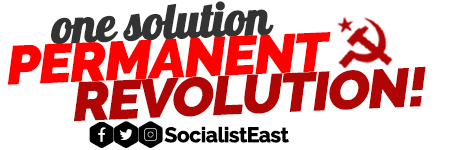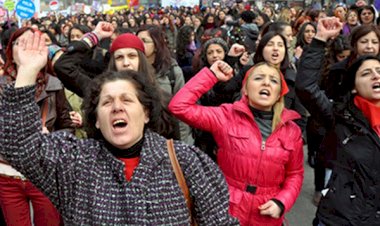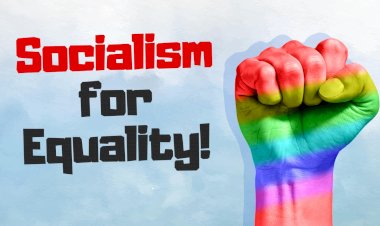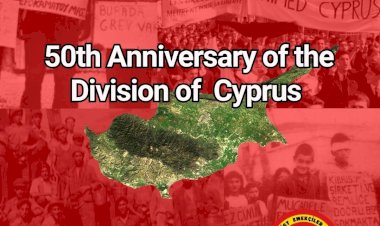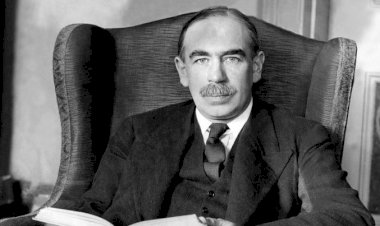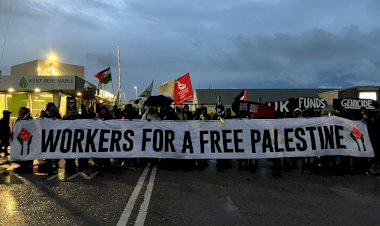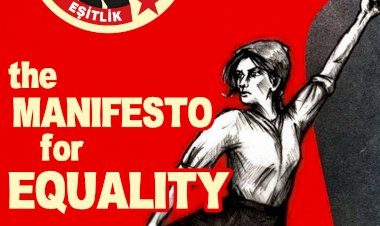Popular but Unassertive: Ideological Problems of Women’s Struggle in Turkey and its Reflections in Practice
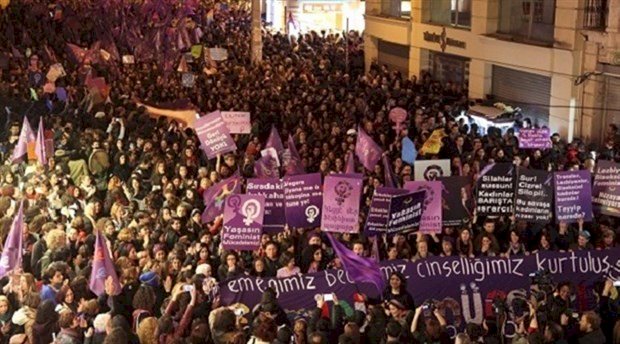
We are going through a period in which women's struggle for freedom and equality has risen with different characters in different parts of the world, but basically with similar contradictions and demands. Right after the 2008 crisis of neoliberalism, right politicians came to power in many countries with aggressive capitalist programs and sexist ideologies against laborers.
Representing the most provocative faces of sexism, these leaders became a trigger for a new movement of reaction: hundreds of thousands of women in the United States took the streets on the very first days of Trump, women organized mass protests against Bolsonaro in Brazil, women’s movement becoming widespread and shaped as a response to the worsening of woman rights under the AKP government in Turkey... While applying the fierce neoliberal program in favor of capital one hand, the AKP in Turkey thus presented to society the ‘social ruin’ created by social conservatization, severe impoverishment, social polarization, pressure on lifestyles and misogyny.
Arising as a mass movement by 1990s in Turkey, woman movement has gained a historical momentum under the rule of the AKP government even though we could see its presence merely on the 8th of March. There is a similar tendency throughout the world. In fact, according to some feminist writers and activists that fourth-wave feminism was born with the following characteristics: rising women's actions in different countries, the power of social media creates awareness and the fact that feminist discourse has become popular in the fields of art, politics, press indicates.
This period is a clear expression of the revival of the claim for equality in the world. Here are some examples at the first glance: widespread women's actions; victory of the Irish abortion referendum; strike for equal pay in Iceland and mass actions in India against mass rape cases; the rise of the "Green Wave" for right to abortion in Argentina. Even during the state of emergency in Turkey, women have carried out many significant protests in front of the parliament against the law proposal that would grant amnesty to rapists.
The dominant character of the wave of struggle is defensiveness to the attacks against women, transgender and homosexual individuals. Excluding Argentina[1] (where millions take to the streets for legalizing abortion under the great influence of socialists) and Ireland's[2] abortion referendum process, the women's movement is currently a defensive movement. Although the worldwide popularization of the women's movement appeals to a wide range of people today; beyond defending vested rights, a women's movement that raises a systematic struggle for new demands cannot be organized. I intend to discuss the reasons in this article.
We are going through a period in which right politics is dominant and the class struggle is quite weak. Nevertheless, the positive momentum of the women's movement has the ability to contribute to the growth of the class struggle and the revival of the social struggle. Therefore, addressing the ideological, political and organizational problems of the rising struggle for equality in Turkey, surely as part of a general tendency in the world, can be seen as a pillar of responding to other vital questions not only about women but also the future of all the oppressed and working people.
Our questions are: What are the ideological problems that make the women question become more and more thorny despite the women’s widespread movement and become an obstacle to achieve gains? How can women advance the general course of the struggle for collective freedom in a period that women's struggle has gained wide legitimacy and is supported with sympathy? While looking for answers to these questions, we need to examine the political nature and program of the actors of the women's struggle and the positioning of the left.
The Divergence of Oppression from Exploitation
After the 2008 crisis, the rise of the far-right across the world was possible due to the disorganization of the working class and the historical crisis of the radical left - especially in Western Europe. The deep economic crisis that disrupted the ordinary functioning of the social order and brought about severe impoverishment, unemployment, insecurity and futility… These factors were politically beneficial for radical politics but because of the fact that socialist movement retreated, the right benefited this trend.
Women were caught unprepared in ideological and organizational terms with the rise of the far-right. During the last 40 years in which identity politics dominated the women's movement, the women and LGBTI struggle broke with an anti-system radicalism and they were divided due to the tensions between different identities. With the rejection of emancipation ideologies that are labeled as “grand narratives”, the islets of small activism groups became the main means of struggle. The left reinforced its own defeat as being both a part and organizer of this transformation.
An identity-centered perspective dominates the left, which has taken the bait of post-modernism since the 1980s. Although this is presented as “inclusion of the sensitivities of the oppressed in socialist program”, there is a politics shaped around the tensions of identities in socialist circles today[3]. In this process, the left stopped looking at the world through the eyes of workers. At the same time, the perception of postmodernism accusing the ideal of total change (the idea of emancipation and revolution) as a new domination and authoritarian effort has leaked to the left to a certain extent. This perception revealed an exility, which lifestyles were seen as a segmented structure, and which the small and local ones were considered essential and a focus of the struggle. The reflection of this shift was the restriction of women’s movement with the demands oriented to interpersonal relations, thus, the opposition to men; leaving aside the anti-systemic perspective. This lately hegemonic perspective is a serious fiasco in terms of anti-system struggle that is seen as authoritarianism. The struggle between the individuals ( women vs. men, homosexuals vs heterosexuals) is the main program proposed by post-modernism generally dominated the socialist women organizations too.
It has been many years since the socialist program, which accepted the working class as the main subject for breaking down the capitalist order and constructing a new world, has been largely set aside for the revolutionary left. Since then, the left has been in a serious decay. A significant part of the left spends its energy on identity struggles. Working-class can come up as one of these identities at best, but labeled as male, white, homophobic, and nationalist on the scale of identities. And the rulers are extremely happy with this situation. There could be no better "left" politics that suit the system’s interests. In short, while the laborers -as the main actors who can change the capitalist order- are ignored, now, what we have is the left focus on the struggle of oppressed who are divided around identities that cannot be united around common interests as all the identities are the enemies of each other.
Feminism also had its share of this transformation. Although there are different versions on a wide scale from right to left, the ideological basis with which feminist approaches compromise is the patriarchy theory. The theory of privileges, which rose in the 1990s and prescribed the “battle” of identities, became good compatible friends with the theory of patriarchy. These were accompanied by the ideas of post-modernism such as the end of grand narratives, invalidness of class struggle and that a universal women question could not exist. Experience-oriented identity definitions have led to justify that it is impossible for oppressed people to organize common struggles, claiming that all kinds of sexual identities experience different types of oppression. The thesis of traditional liberal right-wing thought “a man is a wolf to another man” (homo homini lupus) is perfectly in harmony with the “an identity is a wolf to another identity” thesis. As a result, the laborers and the oppressed have been made extremely vulnerable in ideological and organizational terms to this far-right wave.
The Theory of Patriarchy
Although feminism is divided into various branches with different interpretations, the common starting point is the patriarchy theory based on the contradiction of men and women. Patriarchy theory assumes a male domination that never changes, regardless of the dominant mode of production of society; this is the order in which men continue their privileges and interests. In other words, the source of the oppression of women is the men; although its form has changed throughout history, it has remained the same in substance.
Heidi Hartmann (1979:11) , who calls herself a Marxist feminist and is known with her The Unhappy Marriage of Marxism and Feminism, explains patriarchy as follows:
We can usefully define patriarchy as a set of social relations between men, which have a material base, and which, though hierarchical, establish or create interdependence and solidarity among men that enable them to dominate women. Though patriarchy is hierarchical and men of different classes, races, or ethnic groups have different places in the patriarchy, they also are united in their shared relationship of dominance over their women; they are dependent on each other to maintain that domination.
Hierarchies 'work' at least in part because they create vested interests in the status quo. Those at the higher levels can 'buy off' those at the lower levels by offering them power over those still lower. In the hierarchy of patriarchy, all men, whatever their rank in the patriarchy, are bought off by being able to control at least some women. There is some evidence to suggest that when patriarchy was first institutionalized in state societies, the ascending rulers literally made men the heads of their families (enforcing their control over their wives and children) in exchange for the men's ceding some of their tribal resources to the new rulers (27). Men are dependent on one another (despite their hierarchical ordering) to maintain their control over women.
According to feminist literature, capitalism has two types of production independent from each other: production and reproduction. While “production” in the sense of economic social production is the sphere of the capitalists, the main sphere where the patriarchy continues is basically the home, that is, “reproduction.” According to Christine Delphy (2016:73), in capitalism, the patriarchy shows itself in the field of "reproduction" in the family, that is, at home:
There are two modes of production in our society. Most goods are produced in the industrial mode. Domestic services, child-rearing and certain other goods are produced in the family mode. The first mode of production gives rise to capitalist exploitation. The second gives rise to familial, or more precisely, patriarchal exploitation.
In other words, while in the first of these two forms of production, male and female workers confront their bosses with regard to the notion of exploitation; they have no common interests at home. Moreover, men have an interest in this mechanism, which is already established in the interest of capitalism; “But even if we raise their consciousness, men might assess the potential gains against the potential losses and choose the status quo . Men have more to lose than their chains .” (Hartmann, 1979: 24). Hartmann asserts that Even though the male worker is exploited, because of the fact that the bourgeoisie pays less for women, it has an even more important role in maintaining male control over women's labor as it makes women keep working more and more. According to this view, women are connected by a sisterhood bond based on a common interest. In the theory of patriarchy, class distinctions have become insignificant and women have become the main subject of struggle as a social group that cuts classes vertically.
According to the Patriarchy approach, men are the very reason for women's oppression. This understanding, which places the contradiction between men and women, comes to the conclusion to the point of absolute separation of the struggle. The understanding that “those who benefit from the oppression of women cannot take part in the struggle” causes the anger of women towards social order to be directed towards men. The currents of separatist feminism rising from the second wave of feminism were so disconnected from social reality that Kate Millett would claim that there were no major class differences among women in her book Sexual Politics (1971). Kate Millett's views have been extremely influential in the formation of radical feminism and have been recognized as a cornerstone work.
In her The Dialectic of Sex: The Case for Feminist Revolution, which was published in the USA in 1971 and became the grand text of second-wave feminism, Shulamith Firestone (a founding member of the New York Radical Women, Redstockings, and New York Radical Feminists) claimed that the main dynamic of history is a sexual struggle. According to Firestone, gender inequality did not emerge with class societies, it always existed throughout history. Gender inequality is considered as trans-historical, which means that the situation of inequality will not change with the disappearance of class societies. So, what is the source of the issue? Biology. As long as the biology of women and men exist, as long as the woman carries the curse of giving birth, the man's positioning over the woman will continue. For the solution, technological development is needed to enable men to give birth. The thoughts of Firestone, which is in the references of the left today, have developed in such a contrast with the class view and historical reality.
Let us consider the radical feminist idea of Firestone (great historical alliance of men) reversely: if men have common interests against women, should not all men suffer by the improvements in women's conditions and benefit from worsening (or at least not suffer)? While women workers are the ones who are fired first in times of crisis, do not the male workers left behind have to work with a heavier burden by undertaking the vital responsibilities of their unemployed spouses? Let's take the question one step further; when the bourgeois family, the women’s prison, is abolished; when child and elderly care is socialized; when cafeterias, kindergartens and laundries are established; will it count against the male workers or vice versa? What about male bosses? The former will be liberated as he will actually be freed from the burdens he already carries as part of the family, and the latter will lose his class privileges. Because the great resources to be transferred to social services such as kindergartens, cafeterias will be created by seizing the property of the bourgeois class. There is no use for anyone in trying to explain the oppression of women with claims that have reached the level of imaginary conspiracy theories.
Radical feminism, as seen above, is the extreme example of feminism's explanation of the theory of patriarchy. It is called radical because it dissociates radically from men, not because featuring a revolutionary radicalism.
Privilege Theory and Identities
The theory of privileges, which claims that oppressed identities are subject to a hierarchy among themselves, and that each oppressed identity actually oppresses another identity, creates a discriminatory perspective that makes the unity of struggle impossible.
According to the privilege theory, dominant identities (white, men, Christians in the United States, Sunni Muslims in Turkey, heterosexuals, etc.) have the privilege compared to other identities. Whites are privileged to blacks, cisgenders (those who have the same gender and biological sex) to transsexuals, men to women. Almost every identity is responsible for oppressing another identity; because every identity has an interest in continuing inequalities in line with their privileges. Therefore, there are some serious problems in this perspective in terms of the struggle. First, according to this perspective, identities that are not oppressed can never be part of the struggle; because they have privileges. Secondly, it is not possible for any identity to have a common struggle with another (Choonara & Prasad, 2014). For example, according to this view, a heterosexual feminist reproduces the “heterosexual norms” that cause a trans lesbian woman to be oppressed because her biological sex is also female and has a generally accepted heterosexual sexual identity in society. The existence and the gender roles are just explained by references to themselves and the reduced to the existence of the other identity. For example, privilege theory explains the oppression of women with the existence of men; homophobia with the existence of heterosexuals; disabled with the healthy people. As seen in this example, being a heterosexual cis woman turns into a misdemeanor.
Since the theory of privileges is based on the sharp decomposition of the struggle, it has produced an aggressiveness that causes each identity to approach each other almost with anger. There are many annoying examples of this in street practices. Almost all the oppressed are declared as “wolves”, the idea of a common struggle ground that stems from being oppressed is completely destroyed. Often, even a sympathy among the activists cannot find a chance to appear.
It is highly controversial as to what extent those identities claimed theoretically “privileged” are really privileged. The theory of privileges is fueled by a micro-scale and individualist approach of postmodern doctrine, which completely rejects fundamental contradictions such as class contradictions. It sees the relationship of oppression as arising from interindividual relations rather than social structures.
The harsh political attitude that claims "men can never be involved in the women's struggle" has been the result of not only the patriarchy theory but also the privilege theory. While more left-wing versions of feminism also accept men as a component in the struggle against gender roles, this cannot be the case for those under the thumb of privilege theory.
Privilege theory and patriarchy theory have branched out from the LGBTI struggle in the 1990s with different approaches. In 1990, Judith Butler became the one who established the link between feminism and post-structuralism with her work Gender Trouble, which was accepted as one of the leading texts of Queer theory when it was published. This romantic idealism, where a lifestyle-based rejection is sufficient to get rid of gender definitions and roles, has found a huge audience worldwide. And at all, it did not reveal the rejection of gender identities and genderlessness, as Butler claimed. On the contrary, it was the last straw to an increasingly aggressive polarization of identities. In the manifesto distributed by Queer Nation members during the New York Pride march in June 1990, the following was written:
“ I hate that so many twisted straight people become parents, while I have to fight like hell to be allowed to be a father. I hate straights"...“It is easier to fight when you know who your enemy is. Straight people are your enemy. They are your enemy when they don't acknowledge your invisibility and continue to live in and contribute to a culture that kills you. Every day one of us is taken by the enemy."[4]
This approach is not outdated. Today it has a profound effect on women's and LGBTI+ movement in Turkey. In recent months (2019 summer), We have seen it in “cis-trans women” discussion. The claim that heterosexual men and even women have privileges, no matter what class they belong to, is a claim completely disconnected from social reality. Men commit suicide and burn themselves because they could not fulfill the role of ‘supporting the family’ that is imposed on them in a country where average wages rest on the hunger threshold. Are they also privileged? This view does not distinguish working-class men from bourgeois men and it can easily lean towards a totalism that automatically declares all women progressive while claiming that men collectively oppress women.
Refusing to conceive the world from the class bases and claiming that the world is built around sexual oppression creates such a self-evident apprehension of the world that makes the oppressed completely insensitive, apolitical, vulnerable in the face of the real privileged ones. On the contrary, under capitalism, privileges are gathered in the hands of fewer people, and it must be on the agenda of the oppressed as a central problem affecting their own lives. LindseyGerman (2006) points out the following:
“In capitalism, the only value of the worker is the ability to sell its labour power. When this ability is over for various reasons, such as as elderly age, ,illnesses and surplus labor in the market, workers are even deprived of crumbs that are given to them while they were working. When they are too old to sell their labor force, they are seen worthless by the capitalist society because they are out of the situation that can earn money and therefore spend. This was completely opposed to feudal society, where the old men (the head of the patriarchal family) were the ones who generally held power in the family. However, one of the most important features of capitalism is the weakening of the working class.”
However, post-modern approaches, which are the combination of different variations of it, are fed by deep pessimism, ideally considering individuals as people who will never get rid of their prejudices or never reject their role in oppressing the other: men will not change; Turks are racist and will always remain so; Sunnis are bigots... We can find many more examples of this from the polarization among identities in Turkey. From this understanding, the impossibility of social change emerges (Choonara & Prasad, 2014). The fact that the social opposition is deeply pessimistic against the AKP is due to this ideological ground.
The problem created by the axis of privileges in terms of women's movement has been the elimination of nonconformism. If the oppressing identities will retain their privileges at all costs, the best method of struggle for the oppressed identities is to create their own little islets in which the ‘oppressors’ are precluded. These islets are not to challenge the system at all; on the contrary, it means giving up the purpose of interfering life outside that islet.
The method of discriminatory struggle that is prescribed by radical feminism and the theory of privileges has no correspondence in life. How is it possible to completely disengage the men and women from each other in social life? For it is not so, radical feminist groups opt to create their own small world, rather than struggle for the transformation of large sections of society. In this political line, the lives of upper-middle class women, not poor working women, are at the center. The majority of women have no place in this “liberation”. Now that the "grand narratives" are over, we can evade responsibility and work out for our own salvation! Today, unfortunately, this is the current situation for identity movements particularly in Turkey and Western left. Under these circumstances, there is no wonder that women fail to organize their problems as a social problem.
Neither Patriarchy Nor Privileges Theories
Today, it is not a coincidence that the women's movement put forward the issues that are relevant only to femicides and violence against women, that is, just like in the domestic labor debate, only to confront men and women. The problem for that matter is not the regime's judicatory, ideological and forcible oppression of women in an organized way. As a political choice, even the ‘AKP government’ as a subject is not mentioned in order not to accept the existence of a central power and central contradictions in the common struggle platforms. As such, basing the disclosure of violence on male individuals creates serious weaknesses. Today, femicide keep snowballing, harassment and rape become an everyday issue. Yet, reducing the anger of women to male opposition means closing the door on the social change that women need most today. Since the change does not occur, women are increasingly subjected to worse conditions over and over.
Social revolution will not be possible without combating sexist ideas in society as of today, without bringing the oppressed to a political consciousness that will oppose the oppression, without breaking the widest segments of society from all kinds of racist, nationalist, sexist thought. However, no society in history has changed just by fighting against ideas. This is one of Marx's most basic theses: the point is to change the world in a concrete way. Today, at the center of many thoughts, there are minimal goals that are far from changing the world in a tangible way: such as awareness, expressing equality, consciousness-raising, ‘revolution’ in the language and rejecting social roles. These are the notions that the system can adopt one way or another. The US Embassy hangs a rainbow flag, the parties of the system paint themselves in purple. Emancipation is not possible without aiming for a socialist revolution that will open the door of equality. In our working class-based struggle program, the oppressed are not at the showcase but at the forefront. Standing side by side, we will teach the masses throughout the struggle that defending each identity is a must of revolutionary consciousness. The masses will learn from their own struggle practices and gain the ideological equipment in the class struggle. The realization of change in this direction is the only key to the mass transformation of the society.
However, according to the theory of patriarchy, which opposes the comprehension of society through classes and the linkage of social transformation to class struggle, women should fight independently from men; because men will not give up what they enjoy -including capitalism- to the utmost.
In the radical feminist approaches we have mentioned above, the main problem is deprivation of a historical perspective. Engels made a holistic analysis of the emergence of the relations of oppression in his The Origin of the Family, Private Property and the State, by linking the origin of the women’s oppression to the private property system and the family as an institution that emerged from it. The relations of oppression have existed throughout the history of class societies. However, even the form of this relationship has not remained the same in any period of history. As a key point, we have to be aware that the form of social production, the interests of the ruling class and the lives of the working classes, which are again shaped on the basis of these interests, are constantly changing. Therefore, the position of women in society, inequality and the form of oppression they face are also constantly changing. And this change occurred in parallel with the transformation of exploitation -that is, the way the ruling class seize the surplus product. Perceiving the source of oppression is essential for envisagement of an egalitarian future. Based on neither a self-evident definition of ‘domestic labor’ nor an arbitrary definition of ‘male interest’, a recipe for women's salvation can be written.
Domestic Labor and the Interest of Men
Another remarkable point is that feminists place a special emphasis on domestic labor processes. At first glance, domestic labor is the encounter of the man who sits back and the woman doing endless domestic work. Yet, can this famous scene describe everything? Looking at the situation without establishing the relationship between outside and inside home, men seem to be exploiting women. However, the world outside of the house is the determinant of each work and division of labor; in sum, everything that happens in the house. Focusing inside the house as a phenomenon without considering the outside world seems highly functional in order that the separatist way of struggle and the opposition of women and men can be justified. These same movements ignore the common interest of working women and working men at work; it is a conscious preference that capitalist society in the outside world is not considered as a primary focus. However, we have to analyze outside of the house in order to understand the detachment from production and domestic labor as a burden on women.
The position of women in the production processes has not remained the same throughout capitalism. In the early periods of capitalism, women and children worked in the worst jobs. However, this vicious form of exploitation that provided the bourgeoisie primitive accumulation in record time was not sustainable in the long term. The high rates of child mortality and early childhood illnesses have literally collapsed the population. Capitalism, which employed women and children for a pittance, was destroying future generations. Thus, family-wage emerged as a result of this new social formation in which women and children were condemned to house and men to work. Although the family wage was an extremely sexist ‘solution’, it has been recognized by women as a protection against heavy exploitation, child mortality and diseases. Since women returned home and left the production, they started to determine the value of the capitalist labor power as they were condemned to domestic labor (childcare, elderly care, food, cleaning and raising the next generation of workers) for free. In other words, the position of the woman in terms of capitalist relations was decisive for the amount of family wages (LindseyGerman, 2006). Let's briefly say as follows; domestic labor exists because of wage labor and commodity production!
We must interpret social phenomena on the basis of their historical development. Otherwise, it would be hardly possible to explain why and how the family wage issue -presented as a process in which “male bosses go hand in hand with male workers to recover patriarchy”- was recognized by women.
The narrative that “women are expelled from workplaces and confined to home for the interests of men” evokes that women are very weak. It perceives women as the passive victims of history, as irrational beings whose brains have been washed by the "patriarchy". If ‘submissive’ women, who ‘accepted’ the solution of family wage, agreed to be expelled from the social sphere, the reason for this was the fact that they could not find another way for the relative recovery of their lives at that time. In the same period, the fact that women were frequently used as strikebreakers to ratten male workers' strikes will also remain meaningless in the ‘great alliance of the patriarchy’.
It is a very basic mistake to assume that sexism is a system that works for the benefit of men and to the detriment of women per se. In reality, men and women are convinced of gender roles, men are exploited, women live out their life with domestic labor or work for less money. All of those are legitimized by the socialization of sexism. Marxism claims that the abolition of this ideological perspective can only be possible by eliminating the material processes which sustain it. This great social transformation will mean not only the emancipation of women, but the ultimate termination of the oppression of all gender identities. ‘Women's emancipation’ alone is infeasible.
Socialists’ Migration to Feminism
Feminism's hegemony over socialists brought the shift of main emphases and demands of the woman question from social to individual sphere. To the extent that the emphasis on the problems women face as individuals has brought up the inter-personal conflicts instead of a collective transformation heading towards the social sources of woman’s oppression, the “defeat” of men as a formulation manifested itself in in the socialist feminist jargon. This discourse and program change did not occur by accident. At the origin of this change, there is feminism, which sees all men (not class society or capitalism) as the main enemy, becoming the dominant perspective of the women's movement. Let me also state that the reliance on a simple relationship of contradiction (between man and woman) that seems to work in the capitalist society facilitates the popularization of feminist discourse.
Since the 1970s, which corresponds to the decline of the class struggle in the world, the tendency of the socialists was to shift to identity politics. Britain has the most striking examples. Trade unions, the Labor Party and feminist actors of the women's movement have also experienced this change sharply. Consciousness-raising sessions, small feminist islets and middle-class women's lifestyle demands are inherited until this day. However, times of the most successful gains in women’s socialized demands coincide with the historical periods of strong class movement. Lindsey German expresses this historical period in her successful work, Sex, Class and Socialism:
“Nevertheless, despite the great difficulties faced by revolutionaries after 1945, issues concerning women found their place in the working class movement. In the years of 1940s and 1950s, the issue of equal pay was in the agenda of the unions, and it can be said that the pressure of the unions was effective in the Equal Pay law regulation adopted by the Labor Party government under the leadership of Harold Wilson in 1969. Indeed, the most important post-war reforms on individual sexual freedom have been enacted long before the women's movement emerged in both Britain and the United States. Legal regulations such as the abortion law in Britain (1967), homosexuality (1967), and equal pay (1970) were either enacted before the women's movement started, or much progress was made in the enactment process.”
If we look carefully, the timeframe between the bourgeois (first wave) feminist movement and the second wave feminism is a period of a revolutionary wave making its mark and socialism taking historical steps for equality with the victory of the October Revolution. This period was marked by the socialist women's movement. The successes of the October Revolution changed history forever for all the oppressed. Kindergartens, cafeterias, decriminalization of homosexuality, separation of family and kitchen, abortion… The first material steps that could make women equal in a society were taken.
In the end of 1920s, not only the Soviet revolution but also all its achievements in the history of humanity were destroyed by a counter-revolution. The women returned to the bottomless pit of reactionism, which was deemed by the bourgeois society. As Tony Cliff states, “The mighty sweep of idealism, the courage and soaring hopes of the Bolsheviks, crashed against the terrible backwardness of Russia. Cruel history brought about a sharp contradiction between the grand aspirations of the workers and their actual material and cultural poverty. ” [5]
Examples of misogyny and homophobia occurred not only in Russia, but also in Cuba and China. To the extent that the left called these state capitalist regimes as ‘socialism’, there was nothing left to convey to other social movements. This perspective laid the groundwork for the thesis that socialism as a social project is not "sufficient" for women's freedom and that women's struggle should be carried out within a separate course against men-patriarchy. The reason for the emergence of widespread arguments claiming that “socialism cannot be a solution to the women's problem” should be sought in the embrace of the misogynist and state capitalist regime that was implemented under the leadership of Stalin in the USSR. Of course, there will be no convincing aspect of an understanding that represents women having a job as equality, blesses childbearing, and labels homosexuals as sick. This inconsistency will continue as this history, which is based on the complete destruction of socialism, is defended in the name of socialism. The tradition of Revolutionary Marxists' struggle against this ruin of history stands in a completely different place by separating itself historically.
Due to the debacle of Stalinism in the world, countless women who actively struggled in socialist revolutionary organizations before, joined the feminist movement in the 70s due to the idleness of the left and their reactionism about the women's problem. Of course, the oppressed would create a battlefield that would raise their voices. There was no socialist subject that could prevent blacks, women, LGBTIs and oppressed people to be divided between their identities.
In this era when the third wave of feminism was rising, the ideological ground was based on identity politics formed on individualism, individual experiences, and the rejection of the universal nature of the woman question. To the extent that it could not explain its periodic decline and the collapse of Stalinism on a revolutionary basis, the left quickly defected to feminism, which became increasingly hegemonic. Thus began the story of the socialist left, which intertwined with feminism from the 1980s (4). However, both the theory of patriarchy and the theory of privileges are diametrically opposed to the most basic historical materialistic explanations of Marxism. If one wants to make a slurry with the theory of patriarchy and Marxism, a pile of eclecticism comes out of inconsistencies and contradictions. Heidi Hartmann (1979), who is an important person for Marxist feminism, is also aware of this fact and admits it explicitly in her work titled The Unhappy Marriage of Marxism and Feminism:
“The 'marriage' of marxism and feminism has been like the marriage of husband and wife depicted in English common law : marxism and feminism are one, and that one is marxism . Recent attempts to integrate marxism and feminism are unsatisfactory to us as feminists because they subsume the feminist struggle into the 'larger' struggle against capital. To continue our simile further, either we need a healthier marriage or we need a divorce.”
Today, in no uncertain terms, we are in favor of a healthy divorce. In fact, this oxymoronic union was a mistake from the very beginning. From the perspective of socialist feminists, it is not programmatically and practically meaningful that socialism and feminism are brought together, despite there are many inconsistencies in the analysis of society, the determination of contradiction and the method of struggle. In fact, the organizations which advocate socialist feminism use the discourse of socialism only as a sauce and have established the whole program on feminism. The realization of this divorce would be the best for women's movement. If the left will make a real progress in women's struggle for equality, it must first be ideologically free from these burdens and clarify itself. Marxism and feminism have taken two different paths in history, today that path needs to be re-separated.
Our argument is this: socialism, as a project of an egalitarian society, will create a social transformation that is strong enough to liberate all sexual identities. The strength of Marxism, which connects oppression with exploitation, is that it is a guide to how to destroy this corrupt system. There is no such thing as women's liberation alone. As Clara Zetkin puts it;
“There is no such thing as a ‘woman’s movement’ in and of itself ... (A) women’s movement only exists within the context of historical development and ... there is therefore only a bourgeois and a proletarian women’s movement, which have nothing more in common than does Social Democracy with bourgeois society…
Consequently, the liberation struggle of the proletarian woman cannot be – as it is for the bourgeois woman, a struggle against the men of their own class. She does not need to struggle, as against the men of her own class, to tear down the barriers erected to limit her free competition ... The end goal of her struggle is not free competition with men, but bringing about the political rule of the proletariat. Hand in hand with the men of her own class, the proletarian woman fights against capitalist society.”[6]
Marxism does not postpone gender equality and freedom until the revolution as is claimed. In a society that does not fight for equality today, it is a dream for women and men to achieve a revolutionary transformation. The struggle in all areas starts from today. Weakening the ruling classes in the struggle, gaining self-confidence and revolutionary consciousness is also the key to future great clashes. The most critical aspect of the revolutionary consciousness for the working class is that it corresponds to an advanced consciousness towards the oppressed, as Lenin states; because this corresponds to the awareness that the exploited and the oppressed share the same fate against the ruling classes and understand how the system functions in its entirety:
" Working-class consciousness cannot be genuine political consciousness unless the workers are trained to respond to all cases of tyranny, oppression, violence, and abuse, no matter what class is affected — unless they are trained, moreover, to respond from a Social-Democratic point of view and no other.[7]”
Conclusion
Dynamics in both Turkey and the world are pointing on the development of women's struggle in a positive sense. However, contrary to this lively dynamic, the women's movement cannot show success in achieving concrete gains. Despite the prevalence of protests, we cannot make an improvement in women's deteriorating lives. These issues are worth discussing. We must discuss why we cannot create a movement that manages to achieve concrete gains even though more and more women –especially from the younger generation– see themselves as a defender of women's rights, feminist or egalitarian; in order for our struggle for equality and freedom to succeed, we must give genuine answers to these questions.
In terms of having great legitimacy and revealing the deep contradictions with the regime, we have seen epitomes of women’s struggle in Turkey, having a critical mass potential. Turkish society is going through a stage in which the objective conditions of a social explosion maturate. One of the pillars of this maturity is the women's rebellion that silently established itself. The regime's misogyny, terrible problems of women urgently imposes to build the demands and tools that this potential explosion needs to be prepared for, in terms of women's struggle. How and why is it not possible for women to achieve concrete gains, especially when there is a serious outbreak of femicides, violence against women and child abuse? Why cannot we create a mass struggle that steadily struggles to realize the demands that are socialized by going beyond the instant reactions to significant agendas; why cannot we lead it? The problem is neither in insensitivity nor in underestimation, nor in the lack of activists to fight it. The problem is in the ideological approach of the subjects of the women's movement and its practices.
Today the women's movement in Turkey, with few exceptions, do not have a program that refuses the theory of privileges and patriarchy, as these theories are the ideological pillars of identity polarization. The socialist left stumbles while trying to stand on these two pillars. The theory of patriarchy, which is ideologically impossible to stand side by side with Marxism, results in the abandonment of the latter in favor of the former; bringing with it the weakening of the women's movement that should be seen as a part of the left. Unfortunately, the women's movement, which takes its roots from feminism, is gradually moving away from working-poor women, that is, from the vital problems of the majority of women and getting closer to the middle classes. However, the great power of working women will put forward a practice that will include the other oppressed people of the society. However, the same result does not occur when the opposite happens.
From this day on, we will put equality in domestic labor, on the street and in the workplace to the center of the struggle to gain an egalitarian understanding; however, we must first grasp that equality cannot be possible as long as the family remains as an institution that puts the burden of housework and childcare on women to maximize the profits of capital by reducing the cost of labor-power. For example, when we say that men should do the housework or “let the house go to shit”, we are not actually offering anything to women. We have to weave a political line that brings forward the problems of women who have to do housework, not the few women who have the luxury of not doing housework and that this line must organize the struggle by centering laborers –the women and men. This is because it is not the men who prevent the elimination of domestic labor, but it is the capitalist system, which exploits women and men as workers, and oppresses women.
We can achieve success to the extent that we socialize the struggles that will empower women both individually and socially against all types of oppression. And men must be active subjects in this socialization that will ensure both their own transformation towards women's equality and social transformation with women. This is only possible if men and women march together and men are invited to take responsibility without being externalized to the struggle. Unless we put forward a revolutionary program that perceives life through the eyes of working women and yet confronts all the oppressions, today's political blockage will continue to cost the lives and future of women.
The more defenseless the laborers are today, the more defenseless the oppressed are. This is not a contingency or coincidence. Since, as a strategy, arming the anger of the oppressed with the means of laborer’s struggle has been completely put aside, it is very difficult to achieve gains in the women's struggle despite the broad reactions against the oppression. To the extent that feminism opposes this type of organization ideologically, it also deprives women of the means to succeed, power of discourse and policy. The socialist left has to come out with an urgent ‘u-turn’ from this dead-end street, which it entered before with the integration of feminism’s “male vs. female” policy. It is very difficult to show the will to carry the struggle of women beyond a reflexive protest movement without overcoming the blockage of the socialist left, which has narrowed down to the axis of identities, with a change of shell. We must roll up the sleeves to elude a popular but unassertive movement and create a mass and revolutionary struggle.
In conclusion; a women's liberation struggle, in which a labor program is centered, has the potential to overcome the general stagnation of the left and society. The rise of a socialist movement is a prerequisite for women to achieve gains. In a country where the socialist left does not progress and the labor movement is weak, it will of course be impossible for women to achieve great gains alone. This combined rise will also be the key to overthrow the dictatorial regime.
References
Christine Delphy (2016) The Main Enemy, Verso.
Esme Choonara and Yuri Prasad (2014) What’s Wrong with Privilege Theory? http://isj.org.uk/whats-wrong-with-privilege-theory/
Güneş Gümüş (2018), Identity Politics Benefits the Right , http://socialistmiddleeast.org/identity-politics-benefits-the-right-gunes-gumus
Heidi Hartmann (1979), THE UNHAPPY MARRIAGE OF MARXISM AND FEMINISM TOWARDS A MORE PROGRESSIVE UNION , https://web.ics.purdue.edu/~hoganr/SOC%20602/Hartmann_1979.pdf
Judith Butler (2008) Cinsiyet Belası, Metis.
Kate Millett (2016) Sexual Politics, Columbia University Press.
Lenin (1997) What is to be done?,https://www.marxists.org/archive/lenin/works/1901/witbd/iii.htm
Lindsey German (2006) Cinsiyet Sınıf ve Sosyalizm, Babil.
Shulamith Firestone (1993) Cinselliğin Diyalektiği: Kadın Özgürlüğü Davası, Payel Yayınları.
Sue Caldwell (2017) Marxism, Feminism And Transgender Politics, http://isj.org.uk/marxism-feminism-and-transgender-politics/
Tony Cliff Tony Cliff, Class Struggle and Women’s Liberation, https://www.marxists.org/archive/cliff/works/1984/women/09-revrus.htm
Tony Cliff (1981) , Clara Zetkin and the German Socialist Feminist Movement, https://www.marxists.org/archive/cliff/works/1981/xx/zetkin.html
[1] The right to abortion movement in Argentina, including the Trotskyist radical left and the left Peronists, has managed to create a mass movement in which millions of women took to the streets. The Trotskyist radical left created an important struggle dynamic for the world by showing great organization and action skills on the streets for the women's struggle. However, rejection of the bill by the senate revealed the limits of this movement which is based upon the “protest movements”. Although socialists benefited from this dynamic by actively intervening in the process, inability to connect with the class tools of the working people exposed the limits of dependence on a mere protest movement. However, the right to abortion is highly a class-based demand. Eventually, the system was able to repel this great struggle. We should be able to draw these logical conclusions for the Argentinian left, where the socialist feminist program is dominant. On the other hand, the left Peronists, one of the major components of the movement, unsurprisingly abandoned the struggle for abortion to remedy the bourgeois order which is in crisis and to divert the energy against the right-wing Macri government away from the radical left. The right to abortion was removed from the Peronists' election program because Peronism had to receive the support of the church and the bourgeoisie in order to come to power. The inevitableness of a radical confrontation with the system for the right to abortion has been experienced dramatically in the case of Argentina.
[2] Ireland has historically been made one of the centers of Protestant fundamentalism with the interventions of the British Empire. Ireland, ruled and oppressed by war policies, has been a troublesome country for women's rights throughout history. However, in recent years, the fact that women brought the issue to the agenda as a popular demand has also invoked a discussion among the ruling class; despite the right-wing attacks, the referendum has been won.
For a detailed discussion in Turkish: Derya Koca, The Right to Abortion and Socialists While On The World Agenda Again, http://sosyalistgundem.com/tekrar-dunya-gundemine-gelmisken-kurtaj-hakki-ve-sosyalistler-derya-koca-2/
[3] Güneş Gümüş, Identity Politics Benefits the Right , http://socialistmiddleeast.org/identity-politics-benefits-the-right-gunes-gumus
[5] Tony Cliff, Class Struggle and Women’s Liberation, https://www.marxists.org/archive/cliff/works/1984/women/09-revrus.htm
[6] In Tony Cliff (1981) , Clara Zetkin and the German Socialist Feminist Movement, https://www.marxists.org/archive/cliff/works/1981/xx/zetkin.html
[7] Lenin, What is to be done?,https://www.marxists.org/archive/lenin/works/1901/witbd/iii.htm
